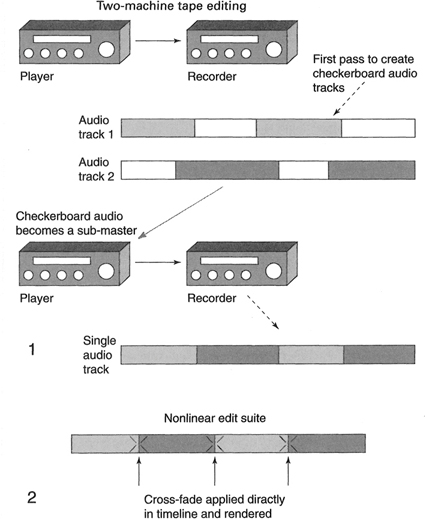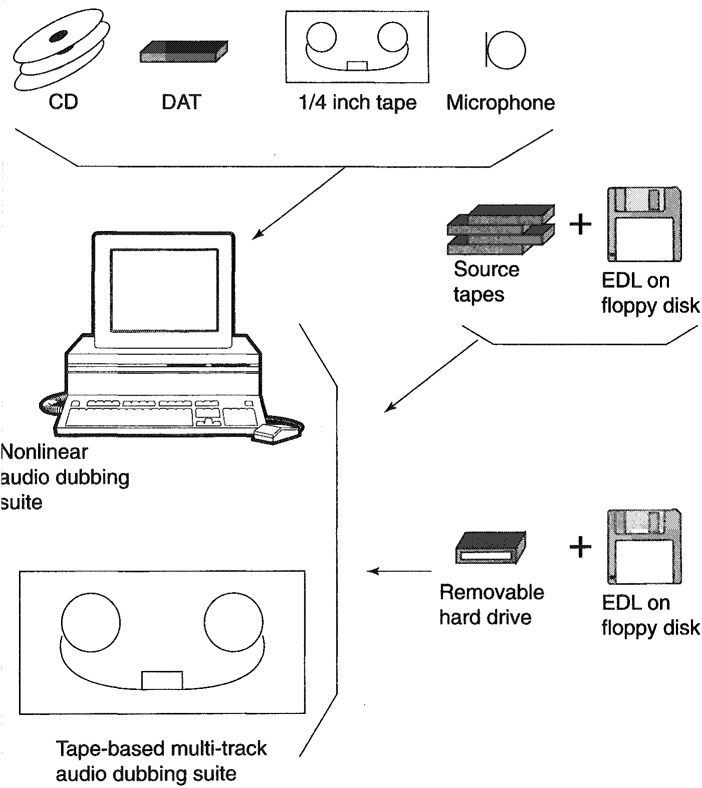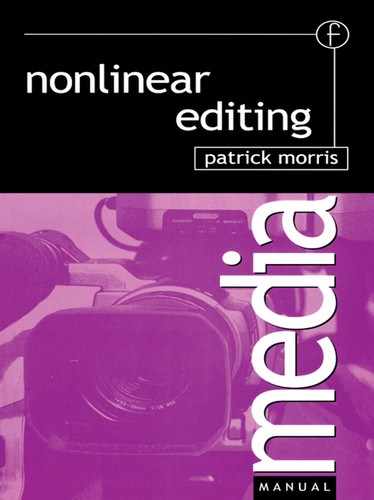Chapter 9
Working with audio
Audio has never enjoyed the ‘glamour’ of video, and consequently al! too often it is not given the respect it deserves, in fact audio is just as important as video – and it might be argued that it is even more important.
A programme with some of the best pictures in the world can be unwatchable if the sound is distorted or muddled. Yet good quality sound with some suspect images can be watchable. Throughout the world this is an everyday occurrence with news. Nonlinear editing systems offer the editor all that could be expected from a tape edit suite and more, but if the audio has not been given the due care and attention at the acquisition stage then even the most sophisticated of systems or the most skilled of audio engineers can do little after the event. All too often for the sake of a few minutes on location, huge penalties can be imposed in the edit suite.
Nonlinear editing systems offer one major advantage over their tape-to-tape video counterparts. That is the ability to handle many audio tracks. While they exist in a virtual environment they are very usable. With television now stereo it is very easy to get to six or more audio tracks very quickly, but on tape you will be lucky to have four audio tracks available. This ability alone makes nonlinear very attractive. Equally, if working with just a voiceover and effects, it is very easy to add audio cross-fades to the effects track to smooth transitions between different audio sounds. On tape this can be very difficult – though not impossible – but all too often an editor will just try to match levels rather than go through the required process of laying off audio to another machine to perform an audio cross-fade. The nonlinear environment offers the opportunity to add a little extra polish to audio with great ease.
Tape versus nonlinear audio

(1) Track-Saying on a simple tape-to-tape edit. Requires two passes to complete the mix, or alternatively a third machine is required. Quite often editors will just match levels.
(2) In the nonlinear environment the cross-fade is applied directly and then rendered. This can also be performed globally by applying a cross-fade on any number of cut-together audio sources.
Audio options for the nonlinear suite
Audio captured to a hard drive during a nonlinear off-line session will be sampled at either 44.1 kHz or 48 kHz (make sure that all audio is captured with a consistent setting for the sampling frequency). In both cases the audio is being sampled at a broad-castable standard. This audio should be set up and monitored as if it was for transmission. If this is done, the audio can be edited and prepared for transmission wholly in the nonlinear system, although this will depend upon the type of programme and existing operational practices.
When an off-line edit is complete, the programme audio can be treated in a number of different ways:
• audio finish in the nonlinear system;
• audio finish in a sound dubbing suite.
Audio finish in the nonlinear system
Finishing audio in the nonlinear suite is quite feasible, provided care has been exercised during the capture process. There are many ‘plug-in’ software modules offering a comprehensive toolkit that can match a sophisticated purpose-built dubbing suite. These include, for example, advanced editing tools and audio effects. There are two points that need to be considered. First, all these specialized plug-in audio tools need to be understood and used with skill, as such an experienced dubbing engineer would be able to perform the audio sweetening much quicker. Many TV programmes require fairly basic sound sweetening such as adding music and some audio balancing, both of which can be done efficiently within a nonlinear system. The second point is that even simple sound balancing does take time and if the programme throughput is high enough then that time spent audio balancing might be better spent editing the next programme.
If the programme is going to be off-lined then on-lined within the nonlinear system, time savings can be made by finishing the audio at the off-line stage and only recapturing the vision at a high resolution to complete the programme. This will save a lot of time with audio line-up and trying to match audio sources to their correct location in the programme when they have not come from timecoded sources.
Audio finish on a nonlinear suite

Audio inputs digitized and edited with sound sweetening using virtual audio tracks. The final audio is rendered or mixed down to a stereo pair for output to tape.
If the vision is going to be auto-conformed in a tape suite then the finished audio can be output to tape with the low resolution vision and the EDL generated as a vision-only edit decision list. The on-line tape suite will then edit the vision onto the finished audio as output from the off-line suite, which will typically save up to 30 to 40 per cent of the on-line tape suite time.
Audio finish in a sound dubbing suite
Audio can be sent to a dubbing suite via its original form, for example from the original source tapes, or it can be delivered in a number of digital forms on a hard disk drive.
For a dubbing operation conforming from the original source tapes an EDL is generated and used to control the recapturing of the audio either onto multi-track or, more commonly, into a digital nonlinear audio dubbing system. Digital nonlinear dubbing suites usually have the capability to work directly with audio supplied on a hard disk. This can be a removable hard disk, but it is important that the audio is in a suitable format for the dubbing suite to work with. Common digital audio file formats are AIFF (Audio Interchange File Format) and OMFI (Open Media File Interchange – developed by Avid Technology).
Wherever possible it is a good idea to communicate with the audio suite that is going to be used. They can then advise on the best route to follow, depending on the type of equipment they have and what is the fastest and most economical way to present audio for their use.
Summary
• Audio should always be handled with care.
• Audio sweetening even at a simple level takes time.
• For some programmes audio can be finished in the nonlinear suite.
• If audio is to be sweetened in an audio dubbing suite then check
• how best to present both the audio and an EDL.
Dubbing suite Input options

(1) Audio can be supplied as original source material on its own.
(2) Audio supplied as EDL and production video source tapes.
(3) Audio supplied as digital media plus EDL on a floppy disk.
